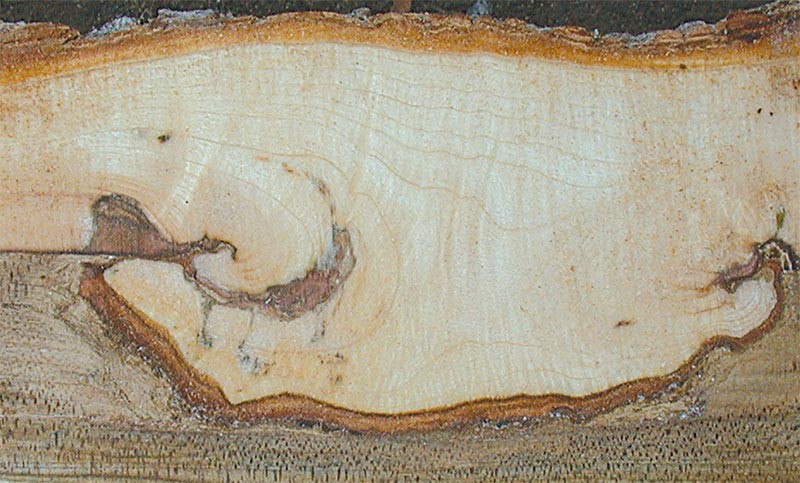
Somehow trees put up with all manner of injury and assault during their lives. They have to: they are rooted in place and cannot move to avoid injury. Whether it’s ice- or wind-stripped branches or dings from the lawnmower, trees are quite commonly beat upon. Indeed, a mature, healthy forest tree might easily have had a thousand wounds – wounds that have the potential to expose the inside of the stem (and thus the rest of the tree) to bacteria and fungi, which can lead to disease, decay, breakage, and death.
In order to survive, trees must overcome their injuries. But technically they don’t heal their wounds, at least not the way that human and animal bodies repair, restore, or replace damaged cells or tissue. Trees are built in layers of cells that are bound by rigid walls in a modular, compartmented way. This structure dictates their wound response.
During each annual growth period, trees build their trunks and branches outward from a layer of actively dividing cells. Increments of new wood are added in a cone shape, enveloping the previous year’s smaller, cone-shaped increment. Picture stacked traffic pylons. Thus, trees grow ever upward and outward, in front of themselves, both in length and in girth.
When a cell is damaged, a tree cannot go back and fix or replace it. But it can limit the damage from any given injury by containing it and excommunicating it from the rest of the still-growing tree. The trick is in sealing, not healing. The focus is on resisting the spread of damage – especially infections of bacteria and fungi and the decay they cause – by isolating the wound and then growing beyond it.
Trees close wounds in two separate processes that create both chemical and physical boundaries around the damaged cells. First, they produce what is sometimes called a reaction zone, altering the chemistry of the existing wood surrounding a wound and making it inhospitable to decay organisms. Then, they build a barrier zone to compartmentalize the injured tissue with new tissue called “callus” or “wound wood” growing outward. If all goes according to plan, the callus growth covers and seals the wound and allows new uncontaminated wood to grow over and beyond it.
Unfettered by bark pressure, the responding callus cells on the edges of a wound grow freely and form elongated rolls. These are the “ribs” of new growth you see incrementally enclosing wounds, such as on an increasingly less visible branch pruning stub. This new growth separates the wood present during the injury from the new wood formed after. The rate and effectiveness of this response differs by tree species and health. Both functions, the chemical and the physical, are necessary but they occur somewhat independently of each other. Rapid wound closure on the outside of a wound does not necessarily indicate that the internal reaction zone has successfully thwarted the spread of an infection.
Understanding the workings of wound response in trees underscores another difference between the way the process works in trees versus people. Whereas we may do well to slather a cut with anti microbial ointment and cover it with a bandage, this is decidedly not helpful to a tree. Applying paint or tar or other dressings and fillers – while a great temptation to tree lovers everywhere – actually interferes with the normal progression of a tree’s wound response and should be avoided. Trees need to seal and close, and generally they do this much better without additives.
It’s not a perfect system and decay abounds in all healthy forests. But when trees are able to compartmentalize wounds and contain them with new growth, infections remain localized and do not spread to existing undamaged, uninfected wood. Given just how prevalent wood rot is in trees – even otherwise healthy, seemingly defect-free trees – it becomes clear how well this tree injury defense system works. Wounds remain encased and the trees simply grow around them.
Every wound ever suffered remains within a tree, but while they may not heal, most trees do get closure.


Discussion *